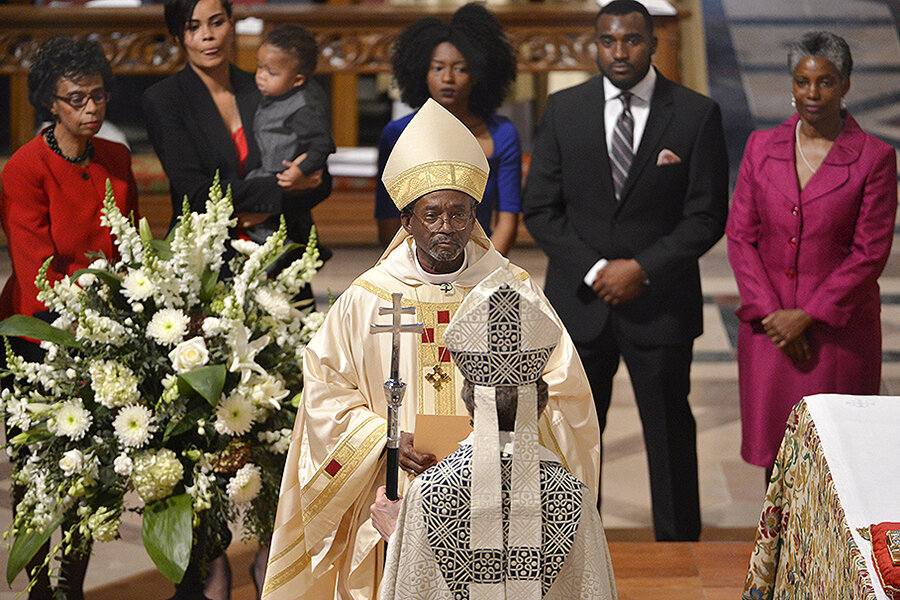Can Episcopal Church's first black leader heal racial divides?
Loading...
Declaring that "God has work for us to do," Bishop Michael Curry was installed as the Episcopal Church's first black leader Monday at the Washington National Cathedral, accepting the ceremonial crozier from outgoing Presiding Bishop Katharine Jefferts Schori, the Church's first female leader.
According to Bishop Curry, the welcome his family found decades ago at the Episcopal Church, which is 83 percent white, set into motion his own journey toward the priesthood, when his mother was handed the same communion chalice as the white parishioners.
Curry's father "was dumbfounded," he told worshippers at Sunday's ceremony. "Years later, he would say he joined the Episcopal Church because he really hadn't imagined that could happen in America. He said any church where blacks and whites drink out of the same cup knows something about the Gospel I want to be a part of."
Curry vowed to continue his predecessor's work towards social justice and racial reconciliation: In 2008, for example, Bishop Jefferts Schori presided at a two-day service to "publicly apologize for [the church's] involvement in the institution of Transatlantic Slavery."
The Episcopal Church is hardly alone in seeking what Christin Taylor, writing for the liberal Christian magazine "Sojourners," called "The White Church's Second Chance." In the sudden intensification of racial social justice efforts following tragedies in Ferguson, Mo., Baltimore, Md., and many others, some traditionally white congregations see an opportunity to right wrongs that they say they have failed to address in the past.
Christianity has a decidedly mixed past, and possibly present, when it comes to racial justice: throughout the abolitionist movement, Civil War, and Reconstruction, for instance, pro- and anti-slavery Christians alike used Bible verses to support their positions.
Ms. Taylor shares her surprise, and pain, to realize that Dr. Martin Luther King, Jr.'s famous "Letter from Birmingham Jail," describing the urgency of change for African Americans, was written from the Baptist minister to fellow men of faith.
"I felt that the white ministers, priests, and rabbis of the South would be some of our strongest allies," Dr. King wrote, yet too many "have remained silent behind the anesthetizing security of stained-glass windows."
As recently as 2011, Harvard professor Michael I. Norton found that white Americans' perceptions of racial injustice differed sharply from those of blacks', with many whites believing it was largely a thing of the past. As The New York Times put it, many of Norton's white respondents' views "diverge far from reality" on issues such as equal pay and health disparities.
But that may be changing: in August, WBBM-TV News in Chicago reported on a poll that showed 44 percent of white Americans consider racism to be "a major problem." In 2010, that number was just 27 percent.
"We voted on if we were going to put a Black Lives Matter sign on our lawn and it was the first unanimous vote in our church's memory," Evanston, Il. Unitarian Church Rev. Bret Lortie told CBS.
Majority-white churches across the country have staked Black Lives Matter banners in their yards. In numerous cases, however, they return to find the signs vandalized — frequently with the word "Black" covered up — or face harassment online, reported UU World, the magazine of the Unitarian Universalist Association.
So many congregations across the denominational spectrum have reported backlash that the Unitarian Universalist Association provides an online resource for churches who find themselves targeted.
The harassment is intimidating, especially for congregations not used to entering social-political fray, but "the experience of having a sign vandalized is only a passing glimpse of the terror of living as a person of color in a racist society," Rev. Jake Morrill, of Oak Ridge UU Church in Tennessee, told UU World's Joshua Eaton. "It was important to me that our congregation not adopt the stance of victim when our sign was vandalized. Our congregation's welfare is not the point of Black Lives Matter."
Baltimore Rev. Dr. Jamal Bryant told the Huffington Post that he believes the movement has brought churches back into the "larger community," where he thinks Jesus would have wanted it. "Much of what Jesus did didn’t happen in the temple," he pointed out.
While protests and banners may signal churches' commitment, they're just a start. Earlier this month, the Episcopal Church organized a "pilgrimage" for young adults to Ferguson, Mo., where they would spend their time on "holy ground" to brainstorm advocacy projects to bring back to their own communities.
"It is incumbent on us, if we are to create a new future, to engage the past," Curry said during his tenure as the Bishop of North Carolina. Congregations must
engage the pain of that past, and to engage the hope of it. There was grievous sin and profound evil and there was incredible courage and nobility. And to claim that courage and nobility anew offers us the possibility of remembering that no matter what the strange mutations of race may be in the days ahead, we can find the moral courage to do what is right, to do what is just, and to build a new society.






